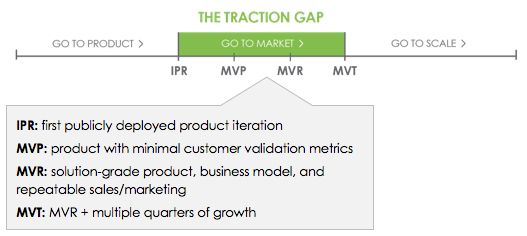Bridging the Traction Gap
PUBLISHED BY Bruce Cleveland
SOURCE PeHub
August 23, 2016
As I discussed earlier this month, 2016 has seen a significant drop in Series B financings. In order to successfully secure follow on rounds of funding, startups must understand how to traverse the Traction Gap and what it takes to get from an initial product release to minimum viable traction.
Author Geoffrey Moore of “Crossing the Chasm,” noted that “traversing the Traction Gap is a unique experience for every company, but there are rules of thumb to leverage.” (Moore is a venture partner at Wildcat Venture Partners.)
We’ve identified four core rules that can help startups traverse the Traction Gap. Here are the first three:
Rule Number One:
Define your initial product release (IPR) – The IPR is when the startup first makes its product generally available to the public. At this stage, the team is seeking customer validation to prove it is on its way to a minimum viable product. The only employees in the company during this stage should be product-related personnel – founders, engineers and product managers. Most companies require between 12 to 18 months to get from idea to IPR.
Rule Number Two:
Identify your minimum viable product (MVP) – This is a debated term, but we define it as the most pared down version of a product that will be purchased or used by customers. The management team should act as the marketing and sales team during this phase. They must learn how to correctly position the company and product, and what it takes to convert interest into demand, usage or revenue. Only after reaching MVP should the company consider bringing on a few dedicated marketing and/or sales resources.
Rule Number Three:
Quantify your minimum viable repeatability (MVR) – We define MVR as the smallest amount of repeatability a startup can execute to demonstrate its business model feasibility. While MVR is an “abstract” point in time, the company must set target metrics it believes will establish that it has reached MVR. Only after reaching MVR should a company consider investing significantly in marketing and sales resources.
It’s important to spend some time on minimum viable repeatability, which is a critical inflection point for most startups. At MVR, the startup has demonstrated it has some understanding as to “how” and “why” customers are acquired. It now knows a significant amount about its target market, has semi-effective product positioning, a reasonable sales pitch, a handle on the primary sales objections and rational responses to them. It also has a few reference customers. The startup can now hire a few sales people and/or invest in marketing and lead generation, and expect it to be fairly effective. That said, repeatability is not just about sales and usage. The startup also should have demonstrated product release repeatability, implementation success repeatability (real customers using the product and getting real value), and some marketing and lead generation repeatability.

To achieve MVR, startups must develop core competencies in the four core architectures: product, revenue, team and systems. These create the foundation to traverse the Traction Gap. This brings us to the fourth important rule:
Rule Number Four:
Drive to minimum viable traction (MVT) – Building on its foundation to reach MVT, a company must continue to measure, refine and optimize each of the four core architectures. Most companies need six to eight quarters of sustained growth beyond MVR to reach MVT.
Understanding the Traction Gap and the important steps a company can take to increase value and decrease risk are essential to securing subsequent financing. In my next article, I’ll dive into the architectural foundation that must be in place to gain the momentum required to traverse the Traction Gap.
Read the original article in PeHub here.
Read the third part of this article series here.
Photo of young businessman jumping over gap courtesy of ©iStock/cherezoff
KEYWORDS